Club América
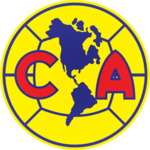 |
|||
| Full name | Club de Fútbol América S.A. de C.V | ||
|---|---|---|---|
| Nickname(s) | Águilas (The Eagles), Super Águilas (Super Eagles), Azulcremas (Blue Creams), Millonetas (Millionaires) | ||
| Founded | October 12, 1916 | ||
| Ground | Estadio Azteca (Capacity: 105,000) |
||
| Owner | |||
| President | |||
| Manager | |||
| League | Primera División | ||
| Bicentenario 2010 | 6th (league) | ||
|
|||
Club América is a Mexican football club based in Mexico City, competing in the Primera División. América is owned by Emilio Azcárraga Jean, who owns Televisa.
América and rivals Chivas share the distinction of being one of the most successful teams in the Mexican first division. América has ten league championships, behind Chivas with eleven. Despite not being the oldest Mexican club, América has achieved more international glory. América has eight FIFA recognized international titles, tied with FC Bayern Munich, Étoile du Sahel, Inter Milan, and Olimpia. They have the most titles of any team from Mexico and from the CONCACAF region. Two other Mexican clubs, Cruz Azul and Pachuca, follow with five and six titles each, respectively.
In the IFFHS's All-Time Club World Ranking, América is ranked 80th, the highest ranked team in Mexico and from the CONCACAF. They are tied with Sporting Lisboa of Portugal, and Fluminense FC of Brazil, and ahead of other top clubs such as CSKA Moscow and Tottenham Hotspur. In recent months, America has struggled to get back into the top 356 clubs.
They play their home games in the Azteca Stadium, the largest stadium in Latin America, and the fifth largest in the world. It has been the host of many major sporting events, such as the FIFA World Cup twice, in 1970 and 1986 (the only stadium to host the finals for this event more than once), the Panamerican Games in 1975 and the Summer Olympics in 1968. This has also been the site for many music concerts, political events, and the appearance of Pope John Paul II in 1999.
América and Chivas share a long-standing rivalry. Their meetings, which have become known as Clásicos, are played at least twice a year and signal a national derby. Having never been relegated to the league's second division, they are the only two clubs to have been in the first division of the Mexican football league from the very beginning. The team mascot, as well as their nickname, is the eagle, or Águila. An eagle is flown around the stadium before games and during half-time for good luck.
Contents |
Foundation
By 1916, football was already a popular sport in Mexico, particularly amongst college students in Mexico City. College students from Colegio Mascarones and Colegio Marista De La Perpetua formed two football teams with the names Récord and Colón. On October 12, 1916, the two squads decided to join to make a more competitive squad. Many names were considered for this new squad, but finally, Pedro "Cheto" Quintanilla, one of the players, suggested América since they had formed the team on Columbus Day (Dia del descubrimiento de América). The players agreed and soon designed a crest which had the map of America with a 'C' for Club and an 'A' for América on each side. After they had created their logo, the players had to decide on their team colors. Rafael Garza Gutiérrez went to get some of his father's navy blue trousers and a yellow shirt and it was decided amongst the group that those would be the club's colors.
Amateur era
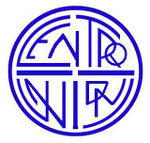
In the year 1916, Club América had to prove itself in order to be accepted into the Mexican Football League, which primarily consisted of foreign players. At the time, América was the only team in Mexico City with an all-Mexican club. Necaxa, Atlante, Real España, Germania, and Asturias were already members of the Liga Mayor De La Ciudad. América's acceptance into the league depended on 3 games. In order to be accepted, América could not lose any of the three games. To the surprise of many, América won two games and tied the third. América was accepted as a result and formed part of the league.
In 1918, the team changed its name to Centro Unión due to bad results with the original name. The new name didn’t fare too well either and was changed back to América in 1920.[1] From 1924 to 1928, América was crowned league champion and was able to attract impressive crowds. In 1926, América became the first Mexican club to play outside of Mexico.[1] Aside from broadening their horizons, Club América along with Atlante petitioned to reduce the number of foreign players in the league. Shortly after the Mexican Football Federation was formed in 1928, Rafael Garza Gutiérrez, América's founder, was designated as the National Team head coach. Most of the Mexican national team that participated in the 1928 Olympics and 1930 World Cup were players that played for América.
Professional era
1940s Mexican League beginnings
Up until 1942, every league in Mexico was considered a regional league even though the league in Mexico City was considered the strongest of them all. In 1942-43, the first National League was established and it was known as the Liga Mayor (Major League). Club América wasn't the team it had been during the 1920s on through the early 1930s. Aging players, lack of resources, and lack of interest took its toll on the club which led the team to become a bottom feeder for much of the beginning stages of the professional era7.
1950s-60s First League title
In 1956, the club was sold to soft drink manufacturer Jarritos. The new owner was trying to build upon the club's National Cup titles in 1954 and 1955 against Guadalajara, their soon to be rival. To the dismay of many, the owner failed to build upon the previous success and onJuly 22, 1959, Emilio Azcárraga Milmo, owner of Telesistema Mexicano (Televisa), bought América from Isaac Bessudo.[2]
It is said in Mexico that the club was founded in 1916, but reborn in 1959, with the vision and values that were set forth by the son of Televisa's founder, Emilio Azcárraga Milmo. The vision he embarked upon was to convert football into a form of entertainment for the masses. Following the acquisition, Azcárraga told his players, "I do not know much about football, but I do know a lot about business, and this, gentlemen, will be a business7".
It was obvious to Emilio Azcárraga that football in Mexico needed an antagonist. The new owner strived to be the villain. Soon after, the club started to spend obscene amounts of money in acquiring foreign talents, which offended fans. Emilio Azcárraga hired the Mexican League's most successful football executive of that time, Guillermo Cañedo, as President. Ignacio Trelles was hired as head coach. It was then that Emilio Azcárraga revolutionized the game of football in Mexico. He laid down a foundation for the club's future by investing in scouting, player development, infrastructure, and merchandising7. He marketed his team both at the national and international level which allowed the club to enjoy financial growth. Under Azcárraga, the team has won 10 League championships, the first being the 1965-1966 season.
1978 First Copa Interamericana
In 1978, América participated in their first Copa Interamericana, playing against Boca Juniors. América would win the championship by a score of 1-0, with a last second free-kick goal by Chilean player Carlos Reinoso. That match would become one of the most famous in history for the club, the competition, and the Estadio Azteca. América would become the first team from Mexico and from the CONCACAF region to win the competition.
1980s The golden age 1983-1991
During the 1980s America was an unforgettable team. They were always considered a favorite to win the championship in any tournament they participated in. They won the league five times, including three consecutive titles: the 1983-84 season, the 1984-85 season, the Prode 1985, the 1987-88 and the 1988-89 season. They also won the Mexican Super Cup twice, in 1987-88 and 1988-89. And they won the 1987 CONCACAF Champions' Cup. During this era America was nicknamed Super Águilas as they won five league championships, three of which were against their archrivals (Chivas, Cruz Azul, and Pumas). Yet, after being Mexico's Team of the decade, it also became the most hated during this season. Fans who opposed Club America during the 1980s were clearly opposing the rules that were being bent favoring America. For instance, the 1985 season was the shortest in history due to the 1985 Mexico City earthquake. The terrible refereeing in the 1987-88 final against Pumas favored America even though Pumas won 1-0. The fans of América replied to this hatred by creating the slogan which in Spanish it became known as: "Odiame mas", which in English translates into "Hate Me Some More" or simply "Hate Me even More".
1990s A decade to forget
The 1990s would be a decade to forget for fans of the yellow clad warriors, with nothing to show for except a CONCACAF Cup in 1990, an Interamericana Cup Championship in 1993, and a CONCACAF Cup Championship in 1992. Years came and went with Televisa spending exorbitant amounts of money on both Mexican and South American players. There were even a few European and African players, as well. This was done with a view to returning the club to its former glory. As it turned out, it was as nothing more than currency that was not well spent, to say the least. Internationally renowned coaches and executives were also brought to the team. This, too, produced no results which just added to the team's woes. The only bright spots of the decade were the appearance of new young stars who were developed in the club's youth squad. These included players like Cuauhtémoc Blanco and Germán Villa that would be instrumental to the team's success later on.
2000s A new century

The new millennium brought renewed hope for Club América's fans, who would be rewarded quickly, with a CONCACAF Giants cup in 2001, the first League championship in 13 years in the summer of 2002, and the team's tenth overall league title in 2005.
In 2006, América qualified for the FIFA Club World Cup. In this tournament, América won its first match against the Jeonbuk Hyundai Motors (Korea). América went on to lose the next match against FC Barcelona (Spain). It ended its participation in the tournament, losing the 3rd place spot to Al-Ahly (Egypt). They finished 4th in the 2006 edition of the FIFA Club World Cup.
2007
After a poor performance in the 2006 FIFA Club World Cup, América started the Clausura 2007 off on a slow start, but quickly recovered and qualified for the playoffs, beating Atlas and Chivas in the quarter and semi-finals. They played the finals against CF Pachuca, finishing runner-ups.
They would then participate in the Copa Panamericana 2007, losing the semi-final match to Boca Juniors 1-0.
América would then participate in the inaugural SuperLiga championship, being eliminated in the group stages with a record of one match won, and two lost.
For the Apertura 2007, after the signings of Argentinians Federico Insua and Lucas Castroman, and Uruguayan forward Hernan Rodrigo Lopez, América looked like a strong favorite to win the title. After starting off the season on a poor run, coach Luis Fernando Tena was sacked as coach, and the job was given to América legend Daniel Brailovsky. They finished the tournament third in their group and sixth in the standings, they played Morelia for the last spot in the playoffs, being beaten 3-0 in the first leg, and winning 1-0 in the second leg. With this, América was eliminated of the competition.
América also participated in the 2007 Copa Sudamericana, reaching the finals to play against Arsenal de Sarandi of Argentina. They would lose the first leg at the Estadio Azteca 3-2, and win 2-1 in Argentina. The aggraget result was 4-4, but due to the away-goal difference, Arsenal won the championship. América finished runner-up.
Although 2007 was a bad year for "Las Aguilas", they managed to stay withtin the Top 20 in the IFFHS's Club World Ranking.
2008
During 2008 the Clausura 2008 saw América end in last place in the general standings. This had not been seen since the mid 1950s. In the first 5 months of 2008, América was showered with 12 defeats, 2 draws and 3 victories, along with three straight championships without qualifying for the playoffs. The coach at the time was Ruben Omar Romano, who was one of the least successful coaches the club has ever had. Ironically, after being replaced by Juan Antonio Luna, América got their third victory of the Clausura over Monterrey 1-0. Then América played well in the Copa Libertadores, beating Brazilian side Flamengo 3-0, thus advancing to the quarter-finals. They were later eliminated from the tournament in the semi-finals.
In the Apertura 2008, América saw a lot of changes to their coaching staff and squad. Guillermo Cañedo White was removed from presidency of the club, and Michel Bauer was named the new president. Bauer's first signing was the new coach, Ramon Diaz. There were also many signings of new players, such as Alfredo Moreno from San Luis, Enrique Vera from LDU Quito, and Juan Carlos Medina of Atlas. The recovery of an injured Federico Insua was also a good sign for the club. Although they have signed very talented players, the results were poor, finishing with only 21 points, and losing to arch-rival, Chivas.
2009
After failing to qualify for the playoffs for a third straight time, América once again spent a large amount of money for players. América's first competition of 2009 was the InterLiga, in which the winner qualified for the next Copa Libertadores. They started off the tournament against rival Chivas. The match ended in a 1-1 draw. Their next match would be against Tigres UANL. The match ended up 3-1, a victory for Las Aguilas. They would then have to beat Atlas to keep fighting for a spot at the South American tournament. They would eventually lose 4-1, despite a 1-0 lead. For not qualifying for the Libertadores, Ramon Diaz's job would be closely watched as the next matches América played in the up coming Clausura tournament would prove pivotal. Diaz would eventually be sacked as coach. The new coach was Jesus Ramirez. With a new coach, América saw a great improvement over the previous 3 tournaments but still failed to qualify for the playoffs for a fourth straight time due to group qualifying standards which were placed by the FMF, finishing 8th place in the general standings with 23 points.
For the Apertura 2009, América was in regulation controversy, but thanks to good results, they did not have to worry about such things. They finished second in their group, and fourth in the general standings. After qualifying for the playoffs, they were eliminated by an inspired CF Monterrey ,which proved to be their toughest game on their journey to the championship, on a 2-1 aggregate score.
Stadium
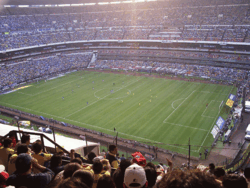
Améric plays its home games at the Estadio Azteca in Mexico City. The stadium was designed by Mexican architect Pedro Ramírez Vázquez, and was inaugurated on May 29, 1966, with a match between América and Torino, which was tied 2-2. The Azteca is also the only stadium in history to host two World Cup finals. The first goal was scored was by Brazilian Arlindo Dos Santos Cruz and the second one by Brazilian José Alves "Zague". The opening game was between Club América and Torino F.C. on May 26, 1966, with seats for 120,000 spectators. Later the Italians tied the game and it ended 2-2. Gustavo Díaz Ordaz President of Mexico made the initial kick and Sir Stanley Rous, FIFA President, was the witness.
A modern lighting system was inaugurated on June 5, 1966 with the first night game between Valencia C.F. and Necaxa. The first goal of the game was scored by Honduran José Cardona. In this game, Roberto Martínez o Caña Brava scored the first goal made by the Mexican team. The final score was 3-1 in favor of Valencia C.F..
There is a Commemorative plaque with the names of the first goal scorer in the first daylight match and in the first night game.
Aztec Stadium is also the site in which Pelé, and Diego Maradona lifted the trophy for the last time. Pelé and Maradona are considered by many as the best football players of all time. This occurred during the 1970 and 1986 FIFA World Cup), the Jules Rimet Trophy and the current FIFA World Cup Trophy, respectively.
The stadium has also hosted the 1968 Summer Olympics, 1970 FIFA World Cup, 1975 Pan American Games, 1983 FIFA World Youth Championship, 1986 FIFA World Cup, and the 1999 FIFA Confederations Cup. It has also hosted major international club tournaments such at the Copa Interamericana and the Copa Libertadores de América.
Aztec Stadium has also been used for musical performances throughout its history. Michael Jackson (in 1993)[3], U2 (in 2006),, Elton John, Maná, Juan Gabriel, Luis Miguel, Gloria Estefan, Jaguares, Lenny Kravitz, Ana Gabriel, The Three Tenors all have become part of the stadium's spectacular history. The stadium has also been used for political events, including Mexican president Felipe Calderón's campaign closure in 2006, as well as religious events, like the appearance of Pope John Paul II in 1999.[4]
Popularity
According to the results of a January 2010 poll, América once again is the most popular soccer club in Mexico with 22.3% of the support, while C.D. Guadalajara trails with 21.2%. The poll conducted by Consulta Mitofsky also shows that América is the most hated team with 40.8% and is followed by C.D. Guadalajara with 16.2%.[5].
Supporters
América have substantial Ultras fan support in the form of barras, the most popular of which is called La Monumental. This barra is unique in that it was not established or even organized by the fans, but rather was created by Nain Lopez, the club's president at the time, who wanted a more family-oriented barra. In addition, the team is supported by "El Ritual del Kaoz" which was created specifically by the fans. Both support groups have members all over Mexico and the United States.
El Clásico
El Super Clásico
- América vs. Guadalajara
- The first confrontation between what are considered the two most popular teams in Mexico ended with a victory for Guadalajara with a score of 1-0.The rivalry began to flourish after the second match when Club América defeated Chivas de Guadalajara with a score of 7-2. Although the huge defeat sparked embarrassment within Chivas, it was almost two decades before the rivalry became The Clásico. Their meetings, which have become known as El Súper Clásico, are played at least twice a year and signal a national derby. One of the very reasons why these two teams are arch rivals is because in 1983 and 1986 these two clubs brawled with each other, raising excitement among the fans, thus every time they play it is considered a match that everyone will remember.[6][7] To this day, El Súper Clásico continues to raise huge excitement in the whole country as well as in other parts of the world where there are fans of either team. The intensity of the game is lived so passionately that every time these two teams contest a game, regardless of what position they are on the charts or what level they show throughout the league, it is always considered the most important game of the season.
Clásico Capitalino
- América vs. UNAM
- The Rivalry between Club América and Club Universidad Nacional known as the "Clásico Capitalino", is one of the strongests rivalries between two of the most popular teams in México,[8] played between two of the three teams which represent Mexico City and the metropolitan area of the Primera División de México.
The first match between these two clubs was on 1 July 1962, where América hosted UNAM who had recently been promoted from the second division.
This match represents two opposites poles in football; América symbolizes lushness and high class of society, while UNAM represents students at the coliegete level since the club is part of the Universidad Nacional Autónoma de México, more importantly Latin America.[9]
Clásico Joven
- América vs. Cruz Azul
- The Clásico Joven is disputed between two of the four most popular teams in Mexico[10] Club América and Cruz Azul. Both teams play in Mexico City, even though Cruz Azul originated out of Jasso in the state of Hidalgo.
Honours
Club América is among the most successful football teams in Mexico, with 10 titles, only one behind rivals Chivas. America has the most international titles with eight, the most from the CONCACAF region and from Mexico. In total, América has 33 official championships, more than any other team from Mexico.
Domestic
Amateur era:
- Campeón de Primera Fuerza : (4)
- 1924-1925, 1925–1926, 1926–1927, 1927–1928
- Campeón de Copa : (1)
- 1937-1938
- Copa Challenger : (1)
- 1927
Professional era:
- Mexican Primera División: (10)
- 1965-1966, 1970–1971, 1975–1976,1983–1984, 1984–1985, Prode 1985, 1987–1988, 1988–1989,Verano 2002, Clausura 2005
- Copa México: (5)
- 1953-1954, 1954–1955, 1963–1964, 1964–1965, 1973–1974
- Campeón de Campeones: (5)
- 1954-1955, 1975–1976, 1987–1988, 1988–1989, 2004–2005
- InterLiga: (1)
- 2008
International
- CONCACAF Champions' Cup: (5)
- 1978, 1987, 1991, 1993, 2006
- CONCACAF Giants Cup: (1)
- 2001
- Copa Interamericana: (2)
- 1978, 1991
- Copa Sudamericana
- Runner-Up: 2007
- FIFA Club World Cup
- Fourth Place: 2006
Friendly
- Copa Independencia: 1966-67, 1974–75
- Junta Española Covadonga: 1927
- Copa Vizcaya: 1920
- Copa Baltamar: 1922
- Liga Excélsior: 1920
- Copa Presidente Gustavo Díaz Ordaz: 1964-65
- Copa Revolución Mexicana: 1980-81
- Copa Pachuca: 1997
- Copa Houston: 2003
- Copa San José: 2006
- Copa "El Mexicano": 2007
- Copa Insurgentes: 2010
International competitions
Copa Libertadores
| Year | PG | W | D | L | GF | GA | PTS | GD | Stage |
|---|---|---|---|---|---|---|---|---|---|
| 1998 | 8 | 2 | 3 | 3 | 7 | 7 | 9 | 0 | Round of 16 |
| 2000 | 12 | 8 | 1 | 3 | 28 | 18 | 25 | 10 | Semifinals |
| 2002 | 12 | 9 | 2 | 1 | 19 | 8 | 29 | 11 | Semifinals |
| 2004 | 8 | 4 | 2 | 2 | 13 | 8 | 14 | 5 | Round of 16 |
| 2007 | 12 | 6 | 1 | 5 | 23 | 16 | 19 | 7 | Quarterfinals |
| 2008 | 12 | 5 | 2 | 5 | 18 | 16 | 16 | 2 | Semifinals |
| Total | 64 | 34 | 11 | 19 | 108 | 73 | 112 | 35 |
Copa Sudamericana
| Year | PG | W | D | L | GF | GA | PTS | GD | Stage |
|---|---|---|---|---|---|---|---|---|---|
| 2005 | 4 | 1 | 1 | 2 | 7 | 8 | 4 | -1 | Quarterfinals |
| 2007 | 8 | 5 | 0 | 3 | 15 | 10 | 15 | 5 | Finalist |
| Total | 12 | 6 | 1 | 5 | 22 | 18 | 19 | 4 |
FIFA Club World Cup
| Year | PG | W | D | L | GF | GA | PTS | GD | Stage |
|---|---|---|---|---|---|---|---|---|---|
| 2006 | 3 | 1 | 0 | 2 | 2 | 6 | 3 | -4 | 4th Place |
| Total | 3 | 1 | 0 | 2 | 2 | 6 | 3 | -4 |
Personnel
Technical staff
| Head Coach | |
| Assistant Coach/Coaches | |
| Additional Coaches | |
| Physical Fitness Coach | |
| Goalkeeping Coach | |
| Team Doctor | |
| Academy Director | |
| Scout |
Board of directors
| President | |
| Vice-President | |
| Sport Director |
Current squad
Note: Flags indicate national team as has been defined under FIFA eligibility rules. Players may hold more than one non-FIFA nationality.
|
|
Reserve team
|
|
Long-term injuries
Note: Flags indicate national team as has been defined under FIFA eligibility rules. Players may hold more than one non-FIFA nationality.
|
Out on loan
Note: Flags indicate national team as has been defined under FIFA eligibility rules. Players may hold more than one non-FIFA nationality.
|
|
Sponsorship
- Nike: Official shirt sponsors
- Bimbo: Official provider
- Coca Cola: Official partner
- Powerade: Official sponsors
- Corona: Official sponsors
- Banamex: Official sponsors
Reserve teams
- America U-20
- Reserve team that plays in the U-20 tournament coinciding with the regular season tournament. The games are held in Estadio Azteca.
- America U-17
- Reserve team that plays in the U-17 tournament coinciding with the regular season tournament. The games are held in Instalaciones Club América Coapa.
Notable players
|
Mexico:
|
Argentina:
Brazil:
Canada:
Chile:
|
Cameroon:
Colombia:
Paraguay
Peru
Romania
Uruguay:
Yugoslavia:
Zambia:
|
Top goalscorers in a season
- 1958-59
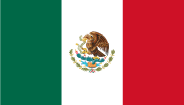 Miguel Nuñez (25 Goals)
Miguel Nuñez (25 Goals) - 1965-66
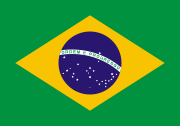 Zague (20 Goals)
Zague (20 Goals) - 1970-71
 Enrique Borja (20 Goals)
Enrique Borja (20 Goals) - 1971-72
 Enrique Borja (26 Goals)
Enrique Borja (26 Goals) - 1972-73
 Enrique Borja (24 Goals)
Enrique Borja (24 Goals) - 1973-74
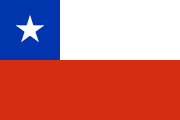 Osvaldo Castro (26 Goals)
Osvaldo Castro (26 Goals) - 1982-83
 Norberto Outes
Norberto Outes - Invierno 1998
 Cuauhtémoc Blanco (16 Goals)
Cuauhtémoc Blanco (16 Goals) - Apertura 2005
 Kléber (11 Goals)
Kléber (11 Goals) - Copa Libertadores 2007
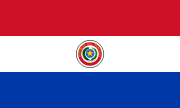 Salvador Cabañas (10 Goals)
Salvador Cabañas (10 Goals) - Copa Libertadores 2008
 Salvador Cabañas (8 Goals)
Salvador Cabañas (8 Goals)
Top goalscorers
- 1
 Luis Roberto Alves (162 Goals)
Luis Roberto Alves (162 Goals) - 2
 Cuauhtémoc Blanco (126 Goals)
Cuauhtémoc Blanco (126 Goals) - 3
 Enrique Borja (101 Goals)
Enrique Borja (101 Goals) - 4
 Eduardo González Palmer (90 Goals)
Eduardo González Palmer (90 Goals) - 5
 Carlos Reinoso (87 Goals)
Carlos Reinoso (87 Goals) - 6
 Zague (86 Goals)
Zague (86 Goals) - 7
 Carlos Hermosillo (79 Goals)
Carlos Hermosillo (79 Goals) - 8
 Salvador Cabañas (71 Goals)
Salvador Cabañas (71 Goals) - 9
 Gonzalo Farfán (70 Goals)
Gonzalo Farfán (70 Goals) - 10
 Octavio Vial (62 Goals)
Octavio Vial (62 Goals) - 11
 Antonio Carlos Santos (58 Goals)
Antonio Carlos Santos (58 Goals) - 12
 François Omam-Biyik (54 Goals)
François Omam-Biyik (54 Goals) - 13
 Hernan Calbaceta (53 Goals)
Hernan Calbaceta (53 Goals) - 14
 Norberto Outes (51 Goals)
Norberto Outes (51 Goals) - 15
 Osvaldo Castro (45 Goals)
Osvaldo Castro (45 Goals)
Champion managers
 Roberto Scarone (1965–66)
Roberto Scarone (1965–66) Jose Antonio Roca (1970–71)
Jose Antonio Roca (1970–71) Raúl Cárdenas (1975–76)
Raúl Cárdenas (1975–76) Carlos Reinoso (1983–84)
Carlos Reinoso (1983–84) Miguel Angel López (1984–85, Prode 1986)
Miguel Angel López (1984–85, Prode 1986) Jorge Vieira (1987–88, 1988–89)
Jorge Vieira (1987–88, 1988–89) Manuel Lapuente (Verano 2002)
Manuel Lapuente (Verano 2002) Mario Carrillo (Clausura 2005)
Mario Carrillo (Clausura 2005)
Presidents
| Name | From | To |
|---|---|---|
| 1916 | 1920 | |
| 1920 | 1930 | |
| 1930 | 1932 | |
| 1933 | 1933 | |
| 1933 | 1934 | |
| 1934 | 1937 | |
| 1937 | 1938 | |
| 1938 | 1939 | |
| 1939 | 1940 | |
| 1940 | 1940 | |
| 1940 | 1945 | |
| 1945 | 1948 | |
| 1948 | 1949 | |
| 1950 | 1954 | |
| 1954 | 1956 | |
| 1956 | 1959 | |
| 1959 | 1961 | |
| 1961 | 1981 | |
| 1981 | 1996 | |
| 1996 | 1997 | |
| 1997 | 1998 | |
| 1998 | 1999 | |
| 1999 | 2004 | |
| 2004 | 2008 | |
| 2008- |
References
- ↑ 1.0 1.1 "Inicia la aventura (1917-1942)." www.esmas.com. Redaccion. (Spanish)
- ↑ "Epoca profesional (1943-1969)." www.esmas.com. Redaccion. (Spanish)
- ↑ "Cronología Estadio Azteca". http://www.esmas.com/estadioazteca/quienes/. Retrieved 2007-09-13.
- ↑ "Pide Juan Pablo II "superar" deficiencias en el progreso social". http://www.jornada.unam.mx/1999/01/26/llama.html. Retrieved 2007-10-12.
- ↑ "LA AFICIÓN AL FUTBOL SOCCER EN MÉXICO". http://72.52.156.225/Estudio.aspx?Estudio=futbol-soccer. Retrieved 2010-02-14.
- ↑ [1]
- ↑ [2]
- ↑ Grupo Reforma. "Encuesta completa sobre el equipo más popular de México". In UNIVISION.com. http://foro.univision.com/univision/board/message?board.id=hinchas_futbol&message.id=270350#M270350.
- ↑ Óscar Ignacio Guevara Salinas. "Pumas vs. América, centenaria rivalidad". In esmas.com. http://www.esmas.com/deportes/futbol/485512.html.
- ↑ Grupo Reforma. "Encuesta completa sobre el equipo más popular de México". In UNIVISION.com. http://foro.univision.com/univision/board/message?board.id=hinchas_futbol&message.id=270350#M270350.
- ↑ "América gana la copa "El Mexicano"". http://www.oem.com.mx/esto/notas/n770203.htm. Retrieved 2009-07-27.
- ↑ http://www.realidadamericanista.com/generales/top100/top100.asp
Sources/external links
- Pasionaguila Blog y Noticias al minuto del Club America
- Official Team Website
-
1 "Club America" Official website
-
2 "Inicia la aventura (1917-1942)." www.esmas.com. Redaccion.
-
3 "Epoca profesional (1943-1969)." www.esmas.com. Redaccion.
-
4 "Mas ligas y el campeonato Intercontinental (1970-1981)." www.esmas.com. Redaccion.
-
5 "America campeonisimo (1982-1998)." www.esmas.com. Redaccion.
-
6 "Otra vez Campeones (1999-actual)." www.esmas.com. Redaccion.
-
8 "Mexican Football Site" www.mediotiempo.com Redaccion.<
-
10 "Otra vez Campeones (1999-actual)." www.esmas.com. Redaccion.
- Fiebre Americanista
- AzulCrema.com "Club America In English"
- odiamemas.com
- clubamerica.t35.com
- Support Website
- Team Anthem
- OleOle's LIVE Coverage of Club America at the FIFA Club World Cup 2006
|
|||||||||||||||||
|
|||||||||||
|
|||||